|
|
|
Sort Order |
|
|
|
Items / Page
|
|
|
|
|
|
|
| Srl | Item |
| 1 |
ID:
188930
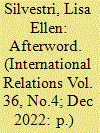

|
|
|
|
|
| Summary/Abstract |
How should we think about war today? This afterword assesses the impact of using a temporal lens to understand contemporary conflict. Reflecting upon my own work on media and war alongside wider societal relationships to violence, I consider the ways in which new technologies and styles of warfighting change both our view of time and our understanding of war itself. In particular, I show how a shift from space to time helps focus attention on the personal and lived experience of US war, on the importance of routines both in constituting and obscuring wartime, on how many issues of contemporary war have become a matter of digitized perspective, and finally how emergent technologies have unsettled familiar temporal patterns of conflict. War today is media-drenched but struggles to occupy our attention over sustained periods. It remains an epochal political force that we tend to approach through deeply individualized, microcosmic stories. It proceeds at breakneck pace but rarely gets anywhere. These questions and tensions underline the importance of focusing not only on the resolutely temporal aspects of wartime, but also on the way in which shifts in time are changing the very nature and politics of war in the 21st century.
|
|
|
|
|
|
|
|
|
|
|
|
|
|
|
|
| 2 |
ID:
188925
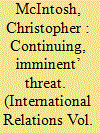

|
|
|
|
|
| Summary/Abstract |
For nearly two decades, the United States has chosen to narrate its response to terrorism through what Judith Butler refers to as the ‘frame of war’. Despite this, victory in that country’s longest war remains largely unimaginable. In some ways this is a problem of time – it is not that victory or an end to the conflict is literally unimaginable, it’s that from our political present, an end appears radically discontinuous. This article builds on recent work using temporality and the political present as a lens and conceptual framework to better understand how temporal assumptions and frames shape the practice of war and political violence. In this article, I show how time and timing play a significant role in justifying the violence of the war on terrorism and in making it intelligible as war. I examine the past three administrations and focus on three areas – the borders of wartime, temporal continuity, and the vision of a post-war future – to show important differences in administrative approaches. To more concretely understand the practice of political violence going forward, attention to the temporal dynamics of politics must be front and center, particularly one possessing ambivalent frames. Doing so reveals the implications these dynamics have for the conduct and permissibility of violence.
|
|
|
|
|
|
|
|
|
|
|
|
|
|
|
|
| 3 |
ID:
188924
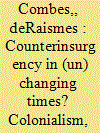

|
|
|
|
|
| Summary/Abstract |
Counterinsurgencies mostly fail, as the 2021 allied withdrawal from Afghanistan illustrates. Still, confronting insurgencies remains a central component in ongoing counterterror efforts around the world. The crux of counterinsurgency (COIN) centers on winning the ‘hearts and minds’ of noncombatants in order to cut militants off from a needed source of material and psychological support. In practice, however, COIN has failed to leverage a pacified civilian population into a military victory and has instead led to protracted engagements with unclear and contradictory goals. I argue that this policy failure can be explained by rehabilitating the doctrine’s colonial heritage to its contemporary deployment. I do so by tracing the doctrinal origins of COIN to American-led pacification programs in Vietnam, Afghanistan, and Iraq. Using time as a conceptual anchor, I draw on postcolonialism and social theory to unearth how embedded imperialist notions of Self/Other in the doctrine help explain this ongoing failure. A temporal lens augments an analysis of COIN in three respects. First, it illustrates the longevity of counterinsurgency as a geopolitical practice of pacifying ‘disruptive Others’. Second, it reveals a paradox in a doctrine that intimates an end state marked by the absence of those disruptive Others but is designed to constantly seek out disruption. Finally, it lays bare differing motivations for the imperial Self to endure the encounter with the Other in the first place. I conclude by reflecting on the potentially harmful consequences both at home and abroad should the underlying assumptions of COIN remain unexamined.
|
|
|
|
|
|
|
|
|
|
|
|
|
|
|
|
| 4 |
ID:
188927
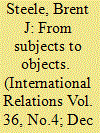

|
|
|
|
|
| Summary/Abstract |
Following the 2004 establishment of the World War II memorial in Washington DC, itself a product of the collective re-commemoration of the so-called ‘Greatest Generation’ of WWII veterans in the US, nonprofit organizations began the practice of ‘Honor flights’. These flights transported US veterans of the Second World War to Washington DC to visit that memorial and other commemorative sites, meet with Congressional members, and return to their local airports to great fanfare and celebration. The practice has evolved to incorporate Korean War and now Vietnam War veterans. As honor flights include much more than the veterans themselves, and as it has become an affectively charged festival for local communities to ‘honor’ their veterans during periods of unresolved wartimes, I articulate the Honor Flight as a treatment for – but also a symptom of – US ontological insecurity in the 21st Century. Honor flights are celebratory, judgmental, and political micro-practices that reflect and reproduce US militarism in ways that will likely outlast the wartimes of the 21st century United States. Along with other micro-practices of US ontological (in)security, Honor Flights threaten to destabilize the politics of military intervention hereafter, and encourage the extension of or inauguration of new times of war.
|
|
|
|
|
|
|
|
|
|
|
|
|
|
|
|
| 5 |
ID:
188926
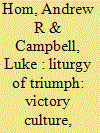

|
|
|
|
|
| Summary/Abstract |
Wartime is fundamentally important to the study of international politics but not especially well understood. In this paper, we use timing theory and the concept of liturgy to unpack the contemporary dynamics of US wartime. A theory of political timing posits that all temporalities derive from and symbolize underlying social processes, and that these timing efforts unfold according to a master organizing standard. Liturgy highlights the way that ritualized acts help participants commune with the sacred – whether this be God or the nation-state. Scrutinizing contemporary US culture practices, we combine these ideas to argue that the notion of victory, as enacted through a widespread set of performative routines, acts as an organizing standard that embeds and reifies wartime in US security policy and daily life. Prevalent ideals of winning wars gather together a stylized past, explicate present problems, and generate expectations about future problems and conflicts. We tabulate several highly influential examples of this liturgy of triumph from national calendars, commemorative sites and events, and cultural practices like spectator sports. In addition to normalizing a view of wartime as having clear beginnings and uniquely successful endings, the US liturgy of triumph highlights a growing gap in the country’s relationship to the use of force. Most of what performative war liturgies commemorate is ‘finished’; it has been seen, known, and ostensibly won. Yet, much of what defines 21st century conflict is anything but certain or victorious. Moreover, US victory culture has only grown more acute the longer the concrete victories fail to materialize, suggesting a tragic code at the heart of US security politics.
|
|
|
|
|
|
|
|
|
|
|
|
|
|
|
|
| 6 |
ID:
188923


|
|
|
|
|
| Summary/Abstract |
Wartime dominates the 21st century. The term is ubiquitous in contemporary politics, providing an intuitive trope for narrating foreign relations, grappling with intractable policy problems, and responding to shocking events. Such pervasion makes it easy to forget that wartime is a relatively recent political invention. It began as an instrumental and somewhat stylized concept that authorized exceptional violence by promising to contain it within strict temporal boundaries. Yet in the same era that wartime achieved international prominence, war itself became an increasingly ordinary and extended dimension of politics. Today, ‘wartime’ refers to a number of unconstrained and often self-perpetuating violent practices that have changed global politics and national security policies in deep and enduring ways – nowhere more so than in the United States. To introduce the special issue, this article presents wartime as a neglected and paradoxical topic at the heart of International Relations. It sketches the concept’s historical emergence, from innovative Presidential discourse through expansion in World War II and the Cold War, to 21st century entrenchment in daily life and habits of foreign relations. We also make the case for why US wartime marks an especially apt example of a global phenomenon, and one worthy of increased scrutiny within International Relations (IR). Finally, we provide synoptic summaries of the articles that comprise the special issue, showing how they work together to interrogate key aspects of 21st century wartime. We conclude with reflections on how the study of wartime may be extended to better understand its impact on historical and contemporary global politics.
|
|
|
|
|
|
|
|
|
|
|
|
|
|
|
|
| 7 |
ID:
188929
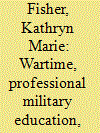

|
|
|
|
|
| Summary/Abstract |
The 2018 United States (US) National Military Strategy claimed that professional military education (PME) in the US had ‘stagnated’. Since then the 2020 US Joint Chiefs of Staff publication Developing Today’s Joint Officer’s for Tomorrow’s Ways of War can be seen as a direct response to such stagnation. The associated temporal positionings of war from stagnation, to today’s officers, to tomorrow’s ways of war, reinforce the significance of wartime in how professional military education is framed. In this paper I ask: To what extent do professional military education mission statements rely on frames of wartime for a construction of purpose, what are the implications of such framings for goals of minimizing violence and suffering, and how may such potential limitations be addressed in the classroom? A focus on wartime can help us draw out significant strategic and ethical challenges of conflict termination alongside ‘forever wars’, the normalization of exceptional security practices and violence, and the way in which prioritizations of either doing war ‘better’ or minimizing the likelihood of war are in seemingly direct epistemological competition. Given a goal of less insecurity, in an era in which fewer and fewer wars actually ‘end’ or ‘end’ with a sense of victory, I assess the extent to which engaging critical approaches in PME may help or hinder the need to challenge self-propagating dynamics of wartime that may be limiting efforts at lessening violence.
|
|
|
|
|
|
|
|
|
|
|
|
|
|
|
|
| 8 |
ID:
188928
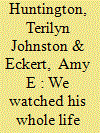

|
|
|
|
|
| Summary/Abstract |
Scholars of war and combat posit that soldiers are more willing to execute strikes on adversaries when they perceive lower risk to themselves or less connection with their targets. Accordingly, technologies like the drone, which drastically expands the distance between adversaries, should make it easier to strike decisively and without remorse. The empirical record tells a different story. Despite operating very far away from the battle theater, drone operators suffer PTSD at the same rate as pilots of manned aircraft. We argue that this unanticipated consequence of drone warfare stems from the unique way in which drone tactics marry spatial distance and temporal duration. Drone operators surveil their targets via detailed video footage for extended periods of time, both before and after firing, in order to identify or locate potential targets, to measure collateral risks, and afterward to assess a strike’s effectiveness. We argue that the clarity and duration of this surveillance tempers any advantage derived from ‘distance’. Spatial distance protects drone operators from enemy fire but temporal proximity exposes them to greater emotional costs of killing than previously thought. Indeed, prolonged observation temporally extends ‘contact’ and mitigates the dehumanizing effects imputed to distance. This unexpected effect highlights a shifting ethical dilemma. In the formulation of the ‘naked soldier’, combatants in a just war deserve respect due to shared vulnerability. Yet while spatial distance physically protects the drone operator, it also requires that they identify vulnerable and legitimate targets through contemporary timing practices that establish intimate knowledge of that target and may thus denude and even heighten the operator’s emotional vulnerability. While others have argued that contemporary wartime features technologies and tactics that undercut conventions about legitimate combat, we uncover an emerging ethical problem in moral and psychological harms associated with the way that drone warfare trades space for time.
|
|
|
|
|
|
|
|
|
|
|
|
|
|
|
|
|
|
|
|
|